When former U.S. congressman and Obama administration chief of staf Rahm Emanuel marched triumphantly into the Chicago mayor’s office in 2011, he promised to revamp Chicago Public Schools (CPS) in ways that had barely been contemplated in 16 years of mayoral control over the city’s sprawling public-school system.
 Longtime Chicago mayor Richard M. Daley had won control over the school system in 1995 and generally received accolades for rising scores on state tests; hard-charging superintendents, including Paul Vallas and Arne Duncan; tough accountability measures such as reduced social promotion; and a slew of new schools and shiny buildings. But the state, the city, and the schools were struggling financially. Chicago shed 200,000 citizens between 2000 and 2010, the only one of the nation’s biggest cities to lose population during that time period. Among big cities, Chicago emerged from the 2008 recession in worse financial shape than most. The 2007 teachers’ contract gave educators a 4 percent salary increase, boosting their compensation well above the state average.
Longtime Chicago mayor Richard M. Daley had won control over the school system in 1995 and generally received accolades for rising scores on state tests; hard-charging superintendents, including Paul Vallas and Arne Duncan; tough accountability measures such as reduced social promotion; and a slew of new schools and shiny buildings. But the state, the city, and the schools were struggling financially. Chicago shed 200,000 citizens between 2000 and 2010, the only one of the nation’s biggest cities to lose population during that time period. Among big cities, Chicago emerged from the 2008 recession in worse financial shape than most. The 2007 teachers’ contract gave educators a 4 percent salary increase, boosting their compensation well above the state average.
And by the time Daley departed in 2011, the 400,000-student CPS had lost its reputation as a cutting-edge school district. Its NAEP (National Assessment of Educational Progress) scores were lackluster (see Figure 1).The district was still offering kids just 170 school days and just over five hours of instruction per day (compared to the national average of nearly seven hours). Chicago had never even made the finals for the Broad Foundation Prize, which is awarded annually to an urban district for marked improvement in student achievement. There were barely more than 100 charter school campuses, serving fewer than 40,000 students. As was the case statewide and elsewhere, the pension time bomb was ticking; pension obligations would soon require more than 10 cents of every dollar CPS spent. At the end of the 2010–11 school year, CPS faced a $1 billion budget deficit.
“There is no other school district in the nation that has as grotesquely underfunded a school system as Chicago,” said Laurence Msall of the Civic Federation.
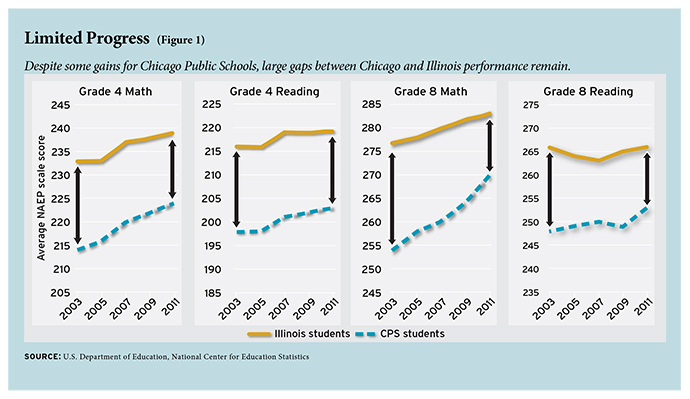
To make a real difference, the impatient Emanuel would have to restore the city’s reputation as an education innovator, retain and attract more parents of school-age children, and confront a series of financial challenges. While no one knew it for sure at the time, there would be no federal Race to the Top funding, nor even, as it turned out, a federal waiver from No Child Left Behind that would free up existing federal dollars for new programs in Chicago. Emanuel and CPS were on their own.
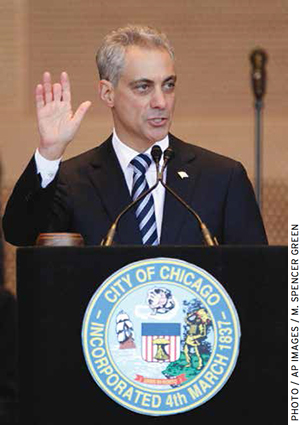
Rushing through the First Year
In April 2011, Emanuel announced an education leadership team headed by Haitian American former Rochester, New York, superintendent Jean-Claude Brizard. There was no listening tour or even a pretense of considering a variety of policy options. (There wasn’t even time for Brizard to speak at the press conference announcing his appointment.) Emanuel was going to do bold, concrete things—enact a longer school day and year, implement principal performance bonuses, expand International Baccalaureate (IB) programs, and revamp teacher evaluations—and get them done as quickly and visibly as possible.
Along with the massive pension liabilities and a long-standing oversupply of school buildings, the district also faced a newly energized Chicago Teachers Union (CTU). The CTU had recently elected a rookie president named Karen Lewis straight out of her high-school classroom. She and Emanuel clashed almost immediately, and Lewis in particular found that her name-calling was effective in the media and with her members. (She claimed that Emanuel swore at her in private, too.)
It didn’t help Emanuel’s relationship with CTU that nearly the first thing he did was to declare that the district was in a “fiscal emergency” and to rescind the teachers’ 4 percent raise for 2011–12, the last year of the final Daley contract. The move was legal under the contract terms and was warranted, according to outside observers, including the Chicago Sun-Times editorial writers. Indeed, teacher salaries in Chicago were higher than in many other large U.S. cities (see Figure 2). At the time, Emanuel might not have been overly concerned that his actions would be extremely unpopular with teachers. Early indications were that Karen Lewis was an effective speaker but not a particularly effective negotiator. Lewis and her team had been steamrolled in Springfield just a few months before, when the state legislature passed a bill that limited Chicago teachers’ ability to strike.
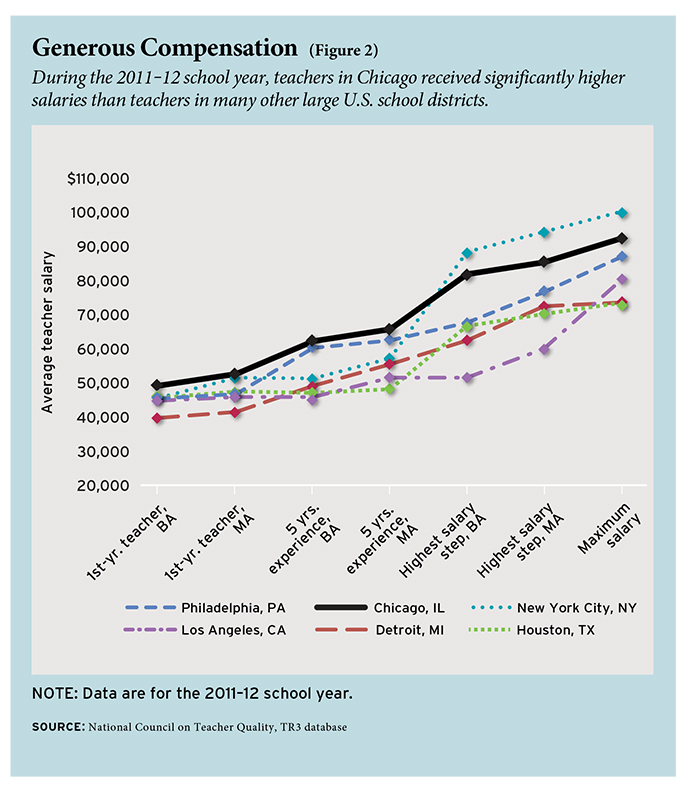
Emanuel’s next move was to call for an immediate citywide extension of the school year and day for 2011–12. But such a move required teachers to waive the current contract, and teachers weren’t inclined to waive the contract just to please the mayor who was taking away their raises. When the dust settled, just 13 schools voluntarily extended the day that year, and the mayor’s rushed effort seemed to have backfired.
Things weren’t going very smoothly inside CPS headquarters, either, thanks in large part to the fact that Brizard had never run a system as large as Chicago’s, hadn’t picked his senior management team, and effectively shared control of the system with Emanuel’s City Hall deputy and his appointed board members. No one was really in charge.
“On any given day, there was a definite lack of clarity on where we were going and how we were going to get there,” recalled a former Brizard staffer, who did not wish to be named. Internal politics “consumed a lot of effort,” and verbal tirades from senior managers weren’t unusual. “It took a lot of work to get the work done,” she recalled. “You felt the turmoil every day.”
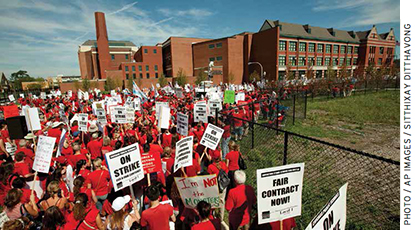
The Impossible Strike
In May 2012, a year into his administration, Emanuel appeared in San Francisco at the annual NewSchools Venture Fund summit, appealing to education funders, reformers, and high-performing charter management organizations to consider coming to the Windy City. Few would take him up on it. The reimbursement rate was too low. The political waters were too choppy. A handful of key CPS staff had already left. Rumors were circulating that Brizard would be forced out soon, and that the teachers might go out on strike.
In theory, striking was nearly impossible. The 2011 law dubbed Senate Bill 7 (SB7) specifically barred Chicago teachers from striking without 75 percent of members’ support, a threshold so high that no one imagined it would be possible to attain. Emanuel and his allies had put the provision into the law hoping to prevent a strike threat from blocking them from making tough moves in the contract and elsewhere. Stand for Children head Jonah Edelman had explained it all in what would become an infamous Aspen Ideas Festival panel appearance the summer before.
What no one seemed to have contemplated at the time was that CTU would open a strike vote well before negotiations had bogged down, but while teachers were still in the classroom, and keep the vote “open” until they got to the required 75 percent. They would essentially precertify a strike and have the members’ approval in their pocket during a long hot summer of negotiations. But that’s exactly what happened.
And so, when negotiations predictably bogged down at the end of the summer, Chicago teachers went out on strike for seven school days at the start of the 2012–13 school year. It was the first such interruption of classes in Chicago in more than 25 years. Neither New York City nor Los Angeles had experienced a strike in at least a decade.
“I remember how many people were on the streets on the strike during the Board meeting,” said special education advocate Rodney Estvan, a former classroom teacher. “The streets were literally filled with one group or another marching down, with their red shirts. It was stunning.”
According to some observers, including Sun-Times columnist Fran Spielman, SB7 “inadvertently” helped generate a strike vote against CPS. According to others, CTU was going to strike one way or the other. Instead of turning Chicago into school reform central, Emanuel seemed to be turning the city into organized labor central.
Who Won?
When the strike ended with a new contract, Chicago teachers generally seemed satisfied with the results Lewis had secured, voting to ratify the contract and basking in the national attention they had won. Lewis and her team would be handily reelected a few months later.
The union didn’t recoup the 4 percent raise that had been rescinded the year before; instead it won raises of 2 to 3 percent per year (or an average of a 17.6 percent pay raise over the period of the contract) on top of the traditional “step-and-lane” raises for experience and degrees. The new contract blocked merit pay. The “fiscal emergency” escape hatch was removed.
Among political observers, it was nearly unanimous that Emanuel “lost” the strike. The strike made for great theater, taking place in the president’s hometown just a few weeks before the 2012 elections, an absolute embarrassment for City Hall. Substantively, many thought that the mayor gave too much away, given the budget and pension problems that were looming. Raises in the new contract were “a significant cost added on without any plan for how it would be paid for,” observed budget watchdog Laurence Msall. Msall estimated that the first year of the new contract would cost CPS roughly $100 million.
Emanuel took the opposite view, airing commercials that listed his wins: a longer school day, principals’ freedom to hire the best teachers, parents’ freedom to choose the best schools, and a teacher evaluation system that would factor in student achievement. Starting immediately, school would run for seven hours for elementary schools, and seven and a half for high schools, and the year would last 180 days (up from 170). Teachers’ hourly rate (which many focused on as a barometer of their compensation) would be lower. There were few job protections for teachers against future layoffs or downsizing that were looming on the horizon. The union agreed to cancel its long-running lawsuits against layoffs that had taken place in 2010, and to continue to allow principals to hire and fire teachers, for the most part.
To start the 2012–13 school year, the union also “won” the resignation of Brizard, who would say in an August 2013 interview that Emanuel was a micromanager, and that he and CPS failed to take CTU and community and parent groups seriously enough. “We severely underestimated the ability of the Chicago Teachers Union to lead a massive grass-roots campaign,” Brizard said.
Indeed, the year leading up to the strike had proven to be a powerful opportunity for Chicago parents to bond with their children’s teachers and union organizers. The union made the case that it was striking for the schools and the students, not for themselves, and many parents seemed inclined to believe them. If parents had any complaints about the strike or the contract provisions won by the union, they were relatively few.
“From a parent’s perspective, I could care less about [the union’s rehire] priority list,” said Jill Wohl, who had helped launch a parent group called Raise Your Hand in 2010 to fight off threatened budget cuts. Otherwise, parent and community groups were generally aligned with the teachers.
Closing Schools
Brizard’s replacement, Barbara Byrd-Bennett, wasn’t as enthusiastic about new and charter schools as Brizard had been, but she was more experienced with larger districts. Most importantly, she was better suited to respond to the public attacks from the union and the near-constant media criticism that would come during 2012–13 as CPS moved to close schools for underenrollment (see Figure 3).
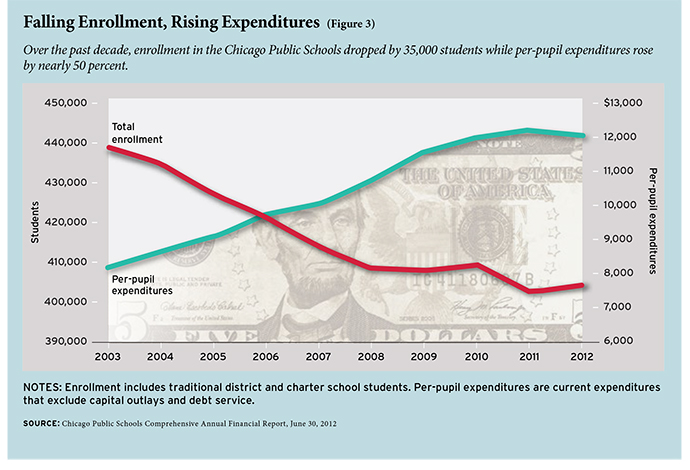
Initial reports were that 80 to 120 schools would be closed. Three hundred schools were on the list of possible candidates. Almost immediately questions swirled about which schools were on the list, and how the calculations were generated, and concerns about the safety of students having to travel to new schools. Incremental declines in total enrollment were just one part of the story: demographic shifts and the appeal of charter schools to African American families both contributed to half-empty buildings being clustered in a small number of neighborhoods.
In the end, the district decided to close fewer than 50 underenrolled elementary schools. Even those who were initially enthusiastic about Emanuel’s education ideas recoiled at the treatment parents received during the school-closing process. “No one trusts you and for good reason,” complained Seth Lavin, a former Teach For America corps member and teacher whose neighborhood school was unexpectedly slated for possible closure (though later reprieved).
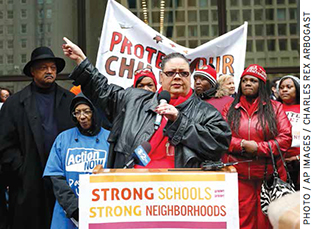
A few teachers blamed the contract Lewis had agreed to for the closings. Some defended the closing process as difficult but necessary, despite its flaws. But most everyone blamed CPS and City Hall. Sun-Times’ editorial page writer Kate Grossman termed the experience of parents and teachers, who for months feared having their school closed without knowing why, a “horrendous rigamarole.”
Emanuel continued to promote charters using the bully pulpit, and CPS was approving more charters even as the district was closing traditional schools. Concerned about the growing political pushback, CPS made two agreements that would likely prove incredibly hard to maintain: a five-year moratorium on any further enrollment-related closings and not to lease or rent empty buildings to charter schools. Schools receiving new students from closing schools were promised upgrades, including iPads for students and air conditioning.
Not surprisingly, given Chicago’s budget woes, the school closings were followed by layoffs and budget cuts. In June, nearly 900 teachers and support staff lost their jobs. In July, another 2,100 were laid off. The layoffs were still an unwelcome follow-up to the strike, and they were made worse by an ill-timed move to a student-based school funding system that put unhappy principals in charge of making layoff decisions. CPS made the budget-cutting process worse by insisting, despite 18 months of talk about a dire money problem, that budgets weren’t going down for 2013–14. Overall spending was up, but funding sent to schools went down 3.5 percent (roughly $68 million).
Since last spring, Lewis has kept up the pressure on Emanuel and CPS. In April 2013, she announced that she would register hundreds of thousands of new voters and run candidates for city council and the state legislature who supported the schools against those who didn’t. “If the mayor and his hand-picked corporate school board will not listen to us, we must find those who will,” declared Lewis. In a June speech at the City Club in downtown Chicago, Lewis asked her well-heeled audience, “When will we address the fact that rich white people think they know what’s in the best interest of children of African-Americans and Latinos, no matter what the parents’ income or education level?” Thanks to Chicago’s long history of youth violence and gang territory conflicts, there were concerns that sending so many students to so many new schools would create additional incidents before and after school.
Working Together to Win Resources
Chicago now has 681 public schools, including more than 130 charter campuses that serve 50,000 of the district’s 400,000 students. The 2013–14 school year opened generally smoothly, with students from the 50 closed elementary schools enrolling at new schools. Some l,600 part-time “Safe Passage” workers lined the streets to watch many of the students come and go from school. The chaos and violence that some had predicted for the start of the year didn’t take place. By the end of September, gun violence had claimed its first CPS student, a 14-year-old boy, but the first two months of the year were relatively quiet. Roughly 1,000 laid-off teachers were rehired. The anniversary of the 2012 strike came and went without any major upheavals.
Behind the scenes, there were some good things going on. A new, more-intensive teacher-evaluation program, developed and piloted largely without rancor during the previous year, was implemented citywide. It created a slower, tougher tenure process for teachers, and would base layoff and recall procedures on teacher evaluations rather than on seniority.
Common Core training was well under way across the city. And the district had finally created a single performance measure that would rate district and charter schools the same way. High school graduation rates have steadily improved.
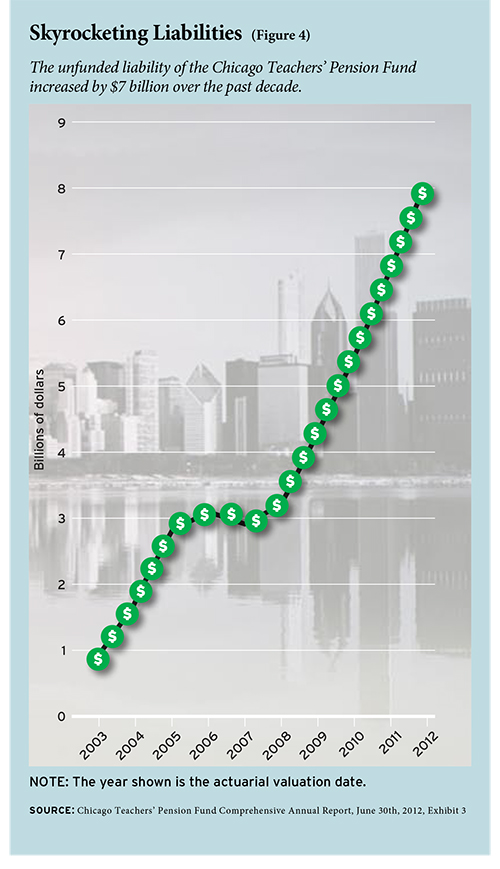 Still, Chicago isn’t out of the woods yet. State test-score data show that in 2013 just over one-third of CPS 11th graders were proficient in reading, compared to 55 percent of their peers statewide. The district’s $5.6 billion operating budget is balanced, technically, but in so doing the school district has left itself extremely vulnerable to financial catastrophe. There will be another $1 billion deficit to face next year and hardly any reserves. Only about 20 percent of the $970 million in savings came from actual spending reductions. The city’s teachers’ pension was funded at just 55 percent of what it should be, leaving a whopping $8 billion shortfall (see Figure 4).
Still, Chicago isn’t out of the woods yet. State test-score data show that in 2013 just over one-third of CPS 11th graders were proficient in reading, compared to 55 percent of their peers statewide. The district’s $5.6 billion operating budget is balanced, technically, but in so doing the school district has left itself extremely vulnerable to financial catastrophe. There will be another $1 billion deficit to face next year and hardly any reserves. Only about 20 percent of the $970 million in savings came from actual spending reductions. The city’s teachers’ pension was funded at just 55 percent of what it should be, leaving a whopping $8 billion shortfall (see Figure 4).
Enrollment in district schools was down again in 2013–14 in parts of the city’s South and West Sides. District revenues were down, too, for the first time in nearly 20 years. And thanks to teacher raises and benefits, among other things, operating costs are up.
Experts disagree about how much money CPS really needs to educate students, but there is no question that Illinois ranks near the bottom among states in its support for education. The state’s contribution was a measly 25 percent, and its targeting of funding (toward low-income, educationally disadvantaged children) was weak.
Chicago’s per-pupil spending in 2012–13 was $13,400, higher than the national average and what is spent in Los Angeles and Houston, for example, but far lower than what is spent in New York City or Boston. Some in Illinois nonetheless believe Chicago already receives more than its share. About one-third of the CPS budget comes from state coffers. Adjustments to the education funding formula made in 2000 have enabled Chicago to lower the property wealth used in the state’s funding calculations, an advantage that many outside the city believe is unfair. The city counts nearly all of its students as low-income for the purposes of state poverty-grant funding.
All that said, Chicago isn’t the only urban school district in the nation struggling with the demands of educating a large number of high-need students. In New York City, state contributions are arguably out of line with student needs. In Philadelphia, enrollment declines are creating enormous problems. In Detroit, the pension problem is even worse.
Chicago isn’t going to turn into Detroit anytime soon, though, thanks to a strong base of property owners. Emanuel nonetheless describes Detroit’s bankruptcy declaration as a “wake-up call.” City property-tax rates are comparatively low, any substantial increase in rates is unlikely to win enough public support to make it through the required referendum, and that hike still wouldn’t raise enough money.
Under normal circumstances, the city’s board of education and the unions would join forces to win more state funding and seek pension relief for Chicago schools. In September 2013, Emanuel made a public attempt to reconcile with Lewis for this very purpose, but it didn’t go far. Even when the Chicago Park District went to Springfield and won some significant pension reforms, CPS and CTU still held off joining forces. The city and union continued to put out wildly different ideas about how to increase funding for Chicago’s schools.
In early December, the state legislature convened and passed a controversial pension reform bill for the state as a whole. But the Chicago teachers’ pension was left out of the deal, and union president Lewis said she wouldn’t agree to anything similar.
For his part, Emanuel was still pressing for a delay to address the city’s pension situation, as unfunded pension liabilities for the city alone reached $19 billion. A $600 million payment would be due in 2014 unless the state gave the city the seven-year extension Emanuel was pushing for. “I’m going to turn this battleship around,” Emanuel told the Sun-Times, but “I’m not going to reverse 30 years of bad practices in just three years.”
Alexander Russo is a former teacher, researcher, and U.S. Senate education aide. He writes two education blogs, “This Week In Education” and “District 299,” and is the author of Stray Dogs, Saints, and Saviors: Fighting for the Soul of America’s Toughest High School.
This article appeared in the Spring 2014 issue of Education Next. Suggested citation format:
Russo, A. (2014). Mayoral Control in the Windy City: Rahm Emanuel battles to improve Chicago schools. Education Next, 14(2), 36-44.


